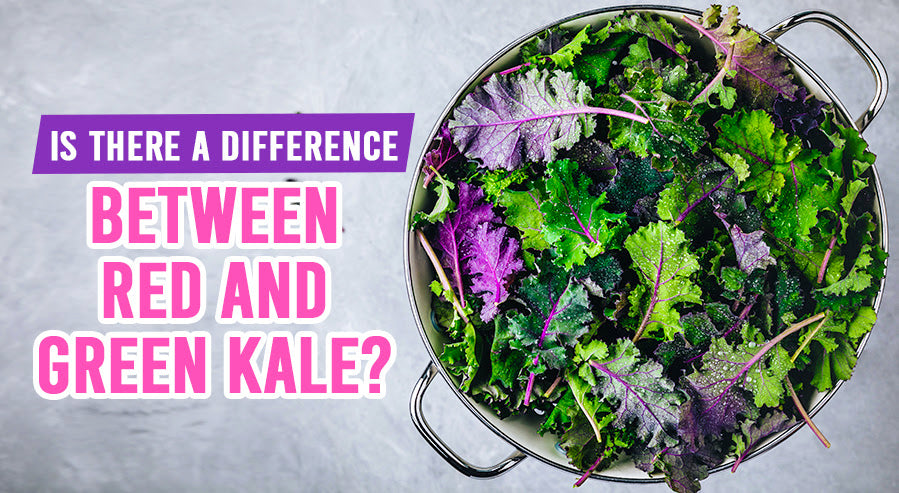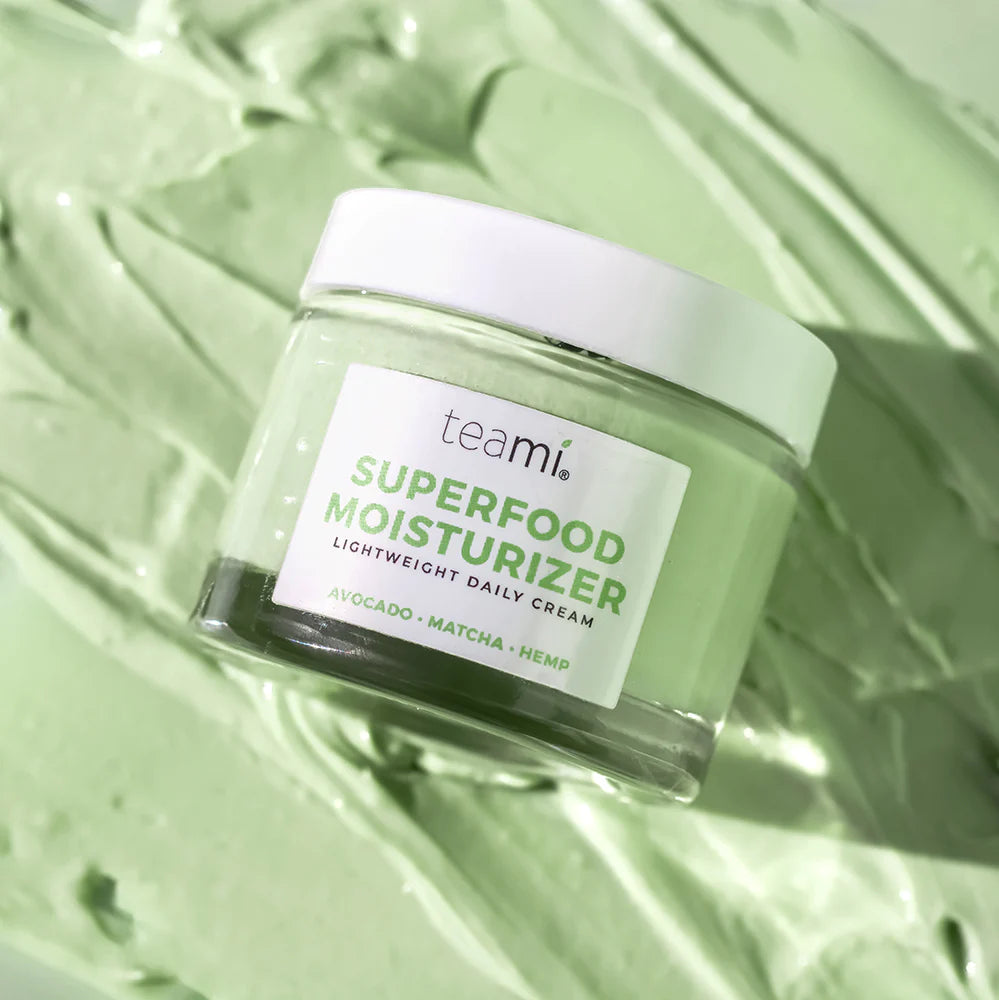Is There a Difference Between Red and Green Kale?

Kale has been a staple in different cultures for centuries and is great for your health. Recently, the comparison between red and green kale has popped up as a topic of discussion - and it's a fun one, especially if you're into your health or cooking.
You get unique things from both types of kale for your body. Red kale, because it's rich in anthocyanins, helps your heart stay healthy and also improves your immune system. Green kale, with its chlorophyll and eye-healthy nutrients, supports your vision and general health, too, and they're both great for you.
So, do you want to see what sets these two kinds of kale apart? Let's get started.
Red vs Green Kale
I recently wrote a post about red and green superfoods (in general); you can read it here.
When you look at red and green kale, you'll see their differences, like in nutrition and health benefits. You might note that red kale is full of anthocyanins, which are antioxidants, and it gives it a reddish-purple color. These things reduce stress and inflammation, actually helping your heart health and immune support. Do the visual differences mean unique nutritional profiles, though?
The interesting thing is that red kale has more vitamin C and beta-carotene than green kale, which means better support for your immune system and skin health. These powerful antioxidants help quite a bit, don't they? Want to manage your blood pressure and your heart health? The nitrates in red kale turn into nitric oxide in your body, which improves blood flow while lowering blood pressure.
Green kale, on the other hand, is known for its high levels of chlorophyll, lutein, and zeaxanthin. So, what do these nutrients do for you? Just to give you an example, chlorophyll helps detoxify your body by binding to harmful toxins and removing them. Lutein and zeaxanthin are helpful for eye health, reducing the risk of macular degeneration over time. You know, if keeping your bones strong matters to you, green kale is your friend. It's rich in vitamin K - which is helpful for strong bones and proper blood clotting.

When you think about digestive health, both red and green kale offer unique benefits. Does the type of fiber matter to you? Red kale has quite a bit of dietary fiber, which improves gut health and fullness and helps with weight management and general digestive health. Also, green kale, along with fiber, has probiotics and enzymes that help with digestion and nutrient absorption.
For more energy and stamina, red kale stands out because its nitrates help with blood flow and exercise performance. Meanwhile, green kale has a balanced nutritional profile with its mix of vitamins and minerals, supporting overall vitality and health.
So, you get it, right? These differences help you make smart choices about adding red or green kale, or both, to your diet. Each kind has its unique benefits, serving different health needs and preferences.
Their Appearance
When you compare red and green kale, you note their specific looks right away. The deep red or striking purple of red kale, also called "scarlet kale" or "red Russian kale," is very unique. Usually, it has red-hued stems too. Its leaves are usually flatter and smaller, which makes them resemble arugula. You might spot baby leaf versions of red kale that are even more tender and delicate.
Think about green kale - what most people think about when they think of kale. Usually, this is curly kale with bright green, ruffled leaves and sturdy stems. Its wider, more fibrous leaves taste a bit more bitter than red kale. Note how the beautiful green color and ruffled texture make it a perfect visual and textural ingredient for salads and garnishes.
Wonder how these differences affect your cooking? Use red kale, with its flatter leaves and slightly milder taste, in recipes where a softer texture is wanted. Try it in warm salads, sauteed as a side dish, or even raw in salads for its tender bite, and it looks aesthetically nice.

Why pick green kale? Its tough structure fits heartier dishes. The fibrous leaves hold up well in soups and stews, and they definitely keep their shape and texture. Enjoy how the slight bitterness adds depth to the overall taste when paired with stronger flavors.
Think about how the look of these kale types can affect presentation. Use the dark and rich hues of red kale to add a splash of color to your plate, as this makes dishes visually attractive. Choose the bright and lush green of curly kale to bring a sense of freshness and health to meals and help with the appeal of salads and other raw dishes.
Stay tuned for a talk about the nutritional profiles of red and green kale. Find the health benefits of each type, and keep reading to find out more!
Their Flavor and Texture
Well, note the difference in flavor and texture when you compare red and green kale. You should taste red kale, and you'll find it a bit sweeter and even more tender. That makes it perfect for raw dishes like salads! You can appreciate its softer and flatter leaves, which are pretty similar to those of arugula. Actually, enjoy red kale when it's young. It is called baby leaf kale, and it adds a delicate touch to your plates.
So, how does green kale stand out? With its harder and peppery flavor, green kale needs massaging or cooking to soften its curly and fibrous leaves. You might find some green kale varieties a bit tender, but you usually should expect a strong bite. Well, not everyone loves kale raw, and this toughness and bitterness are perfect for hearty dishes where the kale can be cooked down and blended with other flavors.

You might want to think about how the differences affect your cooking choices. I recommend red kale's tenderness and mild flavor in fresh and cold dishes where you want to show its best qualities without overpowering the palate. Especially think about salads where its sweet notes balance tangy dressings or raw wraps where its texture adds a nice crunch without being too chewy.
You should switch gears with green kale's peppery taste and sturdy texture, which is perfect for dishes needing some heat. Sauté, steam, or add it to soups and stews and let the cooking process mellow the bitterness and break down tough fibers, making it more fun! Maybe try massaging green kale with a bit of oil or dressing and soften the leaves for raw preparations like marinated salads.
And curious about the nutritional content too? Then talk about that next - you might round out what you know.
Nutritional Variations
When you compare red and green kale, you might find that their nutritional differences can change your choices depending on your dietary goals. Know that red kale has anthocyanins and powerful antioxidants that give it its special red and purple hue. Think about these compounds helping to give you anti-inflammatory and anticancer properties. You'll also find red kale more often sweeter and more tender than green kale, which makes it wonderful for raw dishes and salads. Enjoy the smaller and flatter leaves of red kale - they look quite a bit like arugula - and add a tasty touch to all kinds of meals, which improves your dishes.
Actually, green kale and varieties like Lacinato and Darkibor are rich in valuable vitamins like K and C and beta-carotene. These nutrients help to support blood clotting, immune defense, skin health, and even vision. But you'll often note green kale has a more fibrous and bitter taste. Cooking it can help with its texture and flavor, which makes it a bit more palatable.

Why care about these differences? Well, the darker color of red kale means it has higher levels of specific antioxidants, and it gives you many health benefits. Know that green kale varieties like Scarlet are high in tocopherols and alpha-tocopherol, powerful forms of Vitamin E, which are helpful for skin health and antioxidative roles.
Think about Lacinato kale for its high amount of carotenoids, which are important for eye health and immune work. On the other hand, Darkibor has the highest amount of prebiotic fibers - it improves gut health by feeding good bacteria in your digestive system, which can improve general wellness. Appreciate purple kale for its higher amounts of both carotenoids and anthocyanins - pooling the benefits you see in other kinds with antioxidants and nutrients in a single leaf, and it gives you a rich blend of health benefits.
So, you can use these nutritional differences to customize your dietary choices based on your health needs and flavor preferences!
What Are Their Culinary Uses?
You'll find that specific differences in texture and taste affect how you make and serve these greens. It's interesting that red kale is sweeter and more tender, so it's a flexible choice for many dishes. Its flat and small leaves, like arugula, have a mild flavor and tender feel, which makes it perfect for salads. Try red kale in salads, where its tenderness and subtle taste show their best without overpowering other ingredients. You can sauté red kale with garlic and oil or add it to soups and stews for a colorful and nutritious meal.
On the other hand, green kale has curly and wide leaves - a fibrous texture and a bitter taste. These traits change how you use it in your kitchen. Because of its tough texture, you shouldn't use green kale raw unless you massage it with salt or acid to break down the fibers and reduce bitterness. I think this makes it more fun in salads. Remember that green kale works well when cooked.
You can saute and steam or add it to soups and stews where its toughness and flavor hold up during long cooking times without getting mushy - delicious!

Different kale types, like baby kale and Tuscan kale, fit into your meals in many different ways. Baby kale is very tender and mild, so it needs no massaging or long cooking times. Basically, toss it directly into salads and mix it with other greens for a fresh and delicate flavor.
You should check out Tuscan kale - also known as Lacinato or dinosaur kale - because it balances between extremes. You get flexible options for dishes. With a smoother texture than curly green kale and bigger leaves than baby kale, you can use Tuscan kale in salads, soups, pasta, and slaws. So flexible!
In the same way, try to sauté curly kale with garlic, simmer it in oil, or roast it to get a crispy and flavorful side dish.
Their Availability
When you look at red and green kale, you'll see they show up differently in stores. So, you can easily find green kale in most supermarkets, and they often sell it in bunches or pre-washed and bagged, so it's a staple you'll see in many grocery stores. However, red kale, also known as scarlet kale or red Russian kale, is less common. You might have to check farmers' markets and specialty stores for it.
Well, how does this availability affect your shopping choices? When you're in a hurry and need kale quickly, just choose green kale because it's everywhere. But if you're looking for something less common with a slightly different taste and texture, keep an eye out for some red kale.
Think about their looks, too. So, red kale goes by many names and usually has deep red-hued leaves and stems or a mix of rusty-colored stems and gray and green leaves. It looks almost like curly kale but stands out with its color and flavor. Also, you'll see those red kale leaves are flatter and smaller, pretty similar to arugula. You'll probably find it sweeter and more tender than green kale. It's especially tasty when the leaves are tiny- usually called baby leaf kale- which makes it perfect for salads and raw dishes.

You should note, on the flip side, that green kale, usually curly kale, stands out for its hearty and fibrous texture as this type is more bitter than red kale. I recommend making green kale more attractive - you often need to massage it or cook it. Some green kale kinds are more tender, but overall, it's a tough veggie perfect for stews, soups, and hearty salads. Nutritionally, green kale is full of vitamin K, vitamin C, and beta-carotene, and it's low in calories. These are great nutrients!
Would the nutritional content change your decision? Though both types of kale have nutrients, you might choose green kale if you're looking for higher fiber and a fine addition to cooked dishes. You could, on the other hand, like a milder and sweeter flavor, so red kale could be more attractive, especially for fresh and raw dishes.
These differences can guide your choice based on availability and your specific cooking needs.
Finding The Perfect Blend
As you think about the many details of red and green kale, you see each kind has its own set of unique benefits. Your choice between these types often depends on what specific health gains you're looking for and what dishes you plan to make. Do you lean towards the sweet notes of red kale for your fresh salads? Maybe you like the tough flavor of green kale for hearty soups? It's best to accept both in your diet to give you a balanced strategy for nutrition.
Think about the wider implications of your dietary choices, and you might find greater wellness. I've seen how a small change, like switching to a different kind of vegetable, can have a noticeable effect on your health! You should check out these small yet helpful changes and also observe how your body responds. What other easy dietary swaps or additions might actually offer similar rewards?

When you want to pay attention to your health, finding products that match your goals can make a difference. Enter Teami! You will find a great number of wonderful teas to help with weight loss, better sleep, your immune system, and your general health. Look at our other products that are excellent for both your body and skin and can help you get a healthier glow. So, why not check out our store today and find the perfect natural blend of products to help with your health?
Make that first step towards a healthier lifestyle with choices that are both helpful and fun. You might find your path to better health could be as easy as a soothing cup of tea or a nourishing skincare schedule. I think with Teami, those small and thoughtful choices are right at your fingertips, and they will help you live your best, healthiest life.
Subscribe to our Newsletter
Subscribe to our newsletter and get 10% off your first purchase
 Instagram
Instagram



